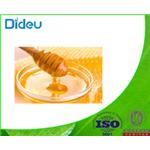Honey
| Odor | at 100.00 %. honey |
|---|---|
| Odor Type | honey |
| Dielectric constant | 24.0(Ambient) |
| FDA 21 CFR | 168.180; 310.545 |
| EWG's Food Scores | 1 |
| FDA UNII | Y9H1V576FH |
| NCI Drug Dictionary | honey |
| EPA Substance Registry System | Honey (8028-66-8) |
| Cosmetics Info | Honey |
Honey Chemical Properties,Uses,Production
Description
To produce honey, the bee draws up the nectar through a proboscis, with the flow routed to the honey sac and isolated from the digestive tract with the proventicular valve. Hypopharyngeal gland secretions mix with the nectar and begin the conversion process. Once the bee returns to the hive the material is vomited up and re-ingested by local workers who repeat this process until the moisture content is stabilized at 82% solids and the sugars inverted. Once this "ripening" process is completed, the honey is sealed in combs with a waxy substance, another secretion of the bee.Despite the lay person’s association of natural products with nontoxic endpoints, antiquity and modem scientific literature cite instances of poisonings from honey. Nectar from a variety of plants, primarily Ericaceae (Rhododendron, Azalea, Andromeda, Kalmia spp.), has produced a toxic product. The consumption of 200+ million pounds of honey yearly in the U.S. without reported incident is testimony to the vigilance of beekeepers. Other toxic honey types are those from the tutu tree of New Zealand (actually a honeydew), henbane (Datura metel), Datura stramonium and Hyoscyamus niger, yellow jasmine (Jessamine), euphorbia and arbutus.1 Honey is not recommended as a food for infants due to the possible contamination of honey with Clostridium spores.2 Honey is generally described in terms of its color and floral type (source of the nectar). Although most honeys are multi-sourced, a few are monofloral types, most often as a consequence of commercial pollenization or simply the absence of competing sources of nectar. Examples of monofloral types include clover, alfalfa, tupelo, "Orange" (actually "citrus" since grapefruit is present), gallberry and cotton (White, 1978). Since honey is considered to be a food, it is regulated according to standards set for food commodities. The standards (grades) for honey are described below. As a food, there is no regulatory limitation on the consumption of honey. Annual per capita consumption of honey (in 1984) was 1.0 lbs (USDA/ERS, 1985). Average daily adult (18+ years) consumption in foods is 2 grams (with a maximum of 71 grams for the 95th centile) (USDA, 1982). (Daily per capita consumption for honey is approximately from 2 grams.) Approximately 212.4 million pounds are produced in the U.S. annually, with 8.7 million pounds exported and another 25.2 million pounds imported. Approximately one-third of the honey in the U.S. is sold directly to the consumer.
Chemical Properties
Viscous liquid which may be partly crystalline, almost white to dark brown.
Uses
honey is said to be soothing, softening, and moisturizing. Masks and other cosmetic preparations containing honey create a watertight film on the face and permit the skin to rehydrate itself. Strong anti-bacterial and immunological properties are attributed to honey. Its use in cosmetics can be traced back at least to ancient egypt and Cleopatra. Honey is composed of a variety of sugars, wax, and other substances, including gluconic, citric, malic, formic, and lactic acids; beta-carotene; enzymes; amino acids; and vitamins. It is a saccharic secretion produced enzymatically from flower nectar that is gathered and stored in honeycombs by honeybees. Honey may cause an allergic reaction in people allergic to pollen.
Uses
Honey is a sweetener that is a natural syrup. it is similar to invert sugar, with a small but variable excess of levulose (fructose). it is formed by the action of the enzyme honey invertase on nectar gath- ered by bees. the composition and flavor varies with the plant source of the nectar, processing, and storage. a typical composition is 41% fructose, 34% glucose, 18% water, and 2% sucrose with a ph of 3.8–4.2. it is 1–1.5 times sweeter than sugar. it also functions to provide moisture, browning, and shelf life extension in some products. it is used in baked goods, cereals, and beverages.
Definition
A unique mixture of a number of lowmolecular-weight sugars (except sucrose) but including invert sugar. It is considerably sweeter than glucose.
Honey Preparation Products And Raw materials
| Supplier | Tel | Country | ProdList | Advantage | |
|---|---|---|---|---|---|
| Henan Tianfu Chemical Co.,Ltd. | +86-0371-55170693 +86-19937530512 | info@tianfuchem.com | China | 21689 | 55 |
| Chongqing Chemdad Co., Ltd | +86-023-61398051 +8613650506873 | sales@chemdad.com | China | 39916 | 58 |
| Shaanxi Dideu Medichem Co. Ltd | 18192627656 | 1012@dideu.com | China | 3167 | 58 |
| Hefei TNJ Chemical Industry Co.,Ltd. | 0551-65418671 | sales@tnjchem.com | China | 34572 | 58 |
| Shaanxi Dideu Medichem Co. Ltd | +86-029-89586680 +86-18192503167 | 1026@dideu.com | China | 9197 | 58 |
| Dideu Industries Group Limited | +86-29-89586680 +86-15129568250 | 1026@dideu.com | China | 28965 | 58 |
| Shaanxi LonierHerb Bio Technology Co Ltd | +86-86-+86-86-029-87551862 +8617702909819 | sales006@ingredients-lonier.com | China | 2596 | 58 |
| Xi'an Jinxiang Pharmaceutical Accessories Co., Ltd. | 029-19991803015 19991803015 | 1309520151@qq.com | China | 127 | 58 |
| BOC Sciences | 1-631-485-4226; 16314854226 | info@bocsci.com | United States | 14059 | 65 |
| Beijing HuaMeiHuLiBiological Chemical | 010-56205725 | waley188@sohu.com | China | 12338 | 58 |
View Lastest Price from Honey manufacturers
8028-66-8(Honey)Related Search:
1of4






